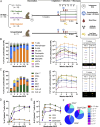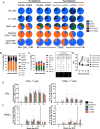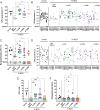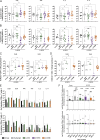Intravenous BCG-mediated protection against tuberculosis requires CD4+ T cells and CD8α+ lymphocytes
- PMID: 39912921
- PMCID: PMC11801270
- DOI: 10.1084/jem.20241571
Intravenous BCG-mediated protection against tuberculosis requires CD4+ T cells and CD8α+ lymphocytes
Abstract
Tuberculosis (TB) is a major health burden worldwide despite widespread intradermal (ID) BCG vaccination in newborns. We previously demonstrated that changing the BCG route and dose from 5 × 105 CFUs ID to 5 × 107 CFUs i.v. resulted in prevention of Mycobacterium tuberculosis (Mtb) infection and TB disease in highly susceptible nonhuman primates. Identifying immune mechanisms protection following i.v. BCG will facilitate development of more effective vaccines against TB. Here, we depleted lymphocyte subsets prior to and during Mtb challenge in i.v. BCG-vaccinated macaques to identify those necessary for protection. Depletion of adaptive CD4 T cells, but not adaptive CD8αβ T cells, resulted in loss of protection with increased Mtb burdens and dissemination, indicating that CD4 T cells are critical to i.v. BCG-mediated protection. Depletion of unconventional CD8α-expressing lymphocytes (NK cells, innate T cells, and CD4+CD8α+ double-positive T cells) abrogated protection in most i.v. BCG-immunized macaques, supporting further investigation into which of these cell subsets contribute to protection after vaccination.
© 2025 Simonson et al.
Conflict of interest statement
Disclosures: S.M. Fortune reported “I serve as a Non-executive Director of Oxford Nanopore Technologies for which I receive financial compensation. ONT sequencing was not used in this study.” P.A. Darrah reported a patent number 11,865,168 issued. No other disclosures were reported.
Figures













References
-
- Bromley, J.D., Ganchua S.K.C., Nyquist S.K., Maiello P., Chao M., Borish H.J., Rodgers M., Tomko J., Kracinovsky K., Mugahid D., et al. . 2024. CD4+ T cells re-wire granuloma cellularity and regulatory networks to promote immunomodulation following Mtb reinfection. Immunity. 57:2380–2398.e6. 10.1016/j.immuni.2024.08.002 - DOI - PMC - PubMed
-
- Capuano, S.V.III, Croix D.A., Pawar S., Zinovik A., Myers A., Lin P.L., Bissel S., Fuhrman C., Klein E., and Flynn J.L.. 2003. Experimental Mycobacterium tuberculosis infection of cynomolgus macaques closely resembles the various manifestations of human M. tuberculosis infection. Infect. Immun. 71:5831–5844. 10.1128/IAI.71.10.5831-5844.2003 - DOI - PMC - PubMed
MeSH terms
Substances
Grants and funding
LinkOut - more resources
Full Text Sources
Medical
Research Materials

